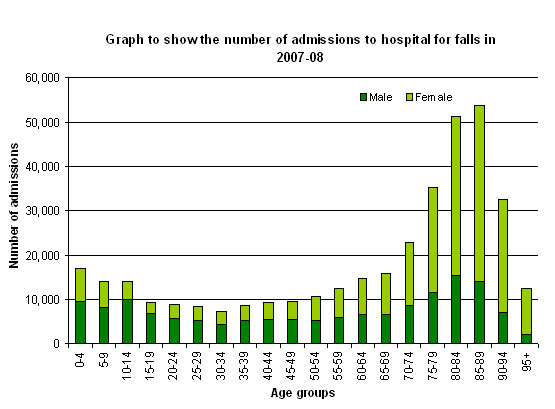
- NHS Choices: Falls
- Inpatient Data
- Self Service
HES on... Falls
This article provides an overview of hospital admissions due to falls in the 2007-08 HES data. Falls are very common accidents with nearly 370,000 being reported last year alone, the majority involved people aged 65 or over. Females represent the higher proportion of people admitted to hospital because of a fall, especially within the 65 or over age group. However, all age groups are susceptible to falls whether this involves children playing, adults in the workplace or an individual slipping in icy conditions. Where the fall results in the individual being admitted to hospital, related data is provided within this article.
How are falls coded in HES?
There are 19 diagnosis codes in HES that a fall can be coded under. These include:
- fall on same level involving ice and snow (W00 in ICD-10)
- fall on same level from slipping, tripping and stumbling (W01 in ICD-10)
- fall on same level due to collision with, or pushing by, another person (W03 in ICD-10)
- fall involving playground equipment (W09 in ICD-10)
- fall on and from scaffolding (W11 in ICD-10).
A fall is coded in one of the 19 secondary diagnosis fields (13 from 2002-03 to 2006-07 and 6 prior to 2002-03), where the primary diagnosis field contains a code showing the consequence of the fall, such as a broken wrist.
Who is affected by falls?
The number of people admitted to hospital due to a fall starts relatively high for younger people, decreases for young adults before increasing slowly at first for adults aged 35 or over. A fall for a younger person can cause severe bruising, and in many cases would not result in hospital attendance, whereas a fall for an older person can lead to broken bones and may take months to heal, leaving them physically restricted and socially isolated.
Although falls are more common with younger children and elderly people, HES data shows that all ages are affected in some way (see graph below).
 |
HES facts and figures
HES data for falls (external cause codes W00 - W19 in ICD-10) show that:
- 92% of total admissions are emergency admissions, ie via A&E;, GPs, Bed Bureau (including the Central Bureau), consultant outpatient clinics or other means, including patients who arrive via the A&E; department of another health care provider
- the average (mean) length of stay in hospital is 8.2 days
- they were responsible for 369,541 admissions, which account for 2,735,902 bed days.
More information on this topic is available from NHS Choices here.

